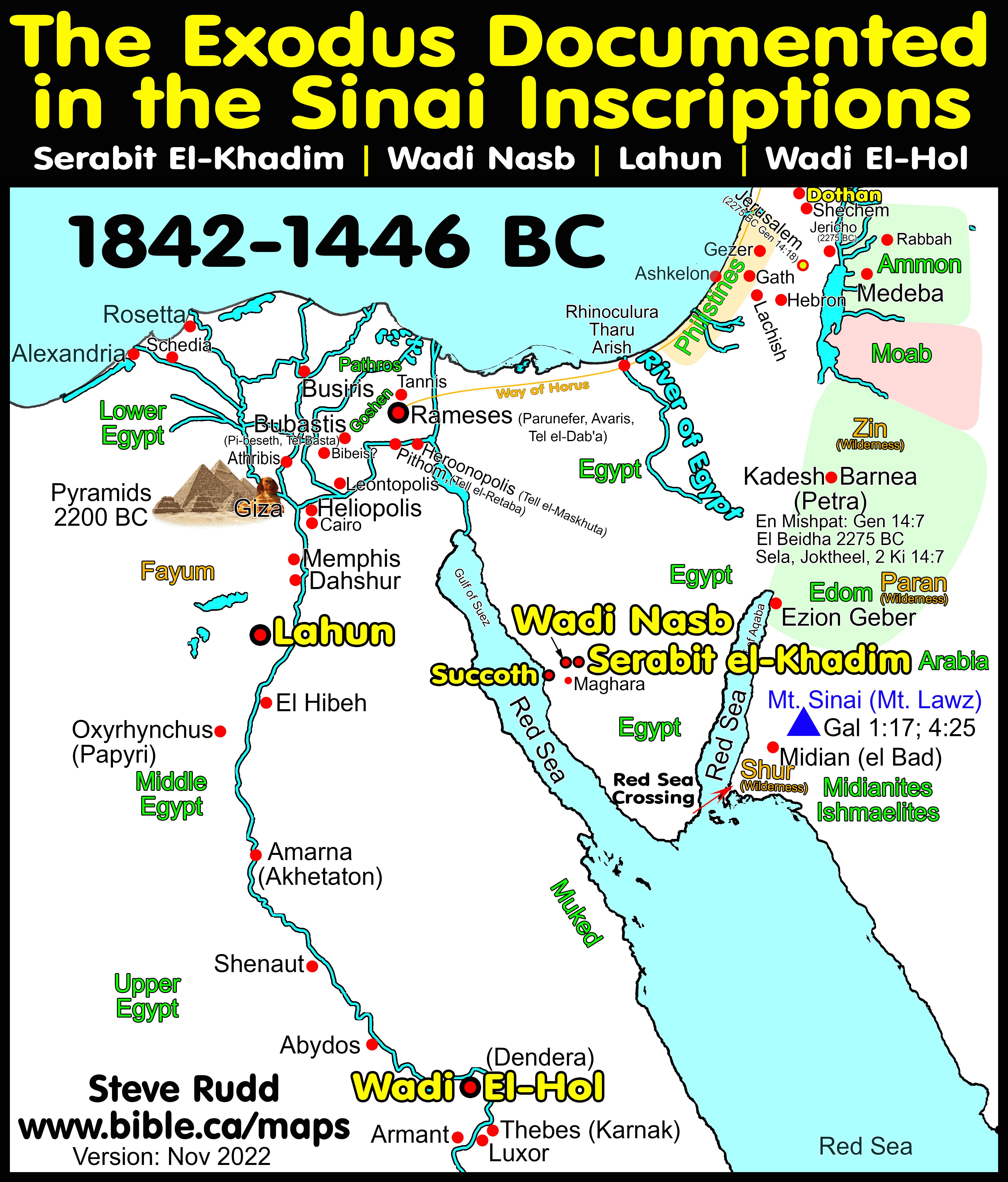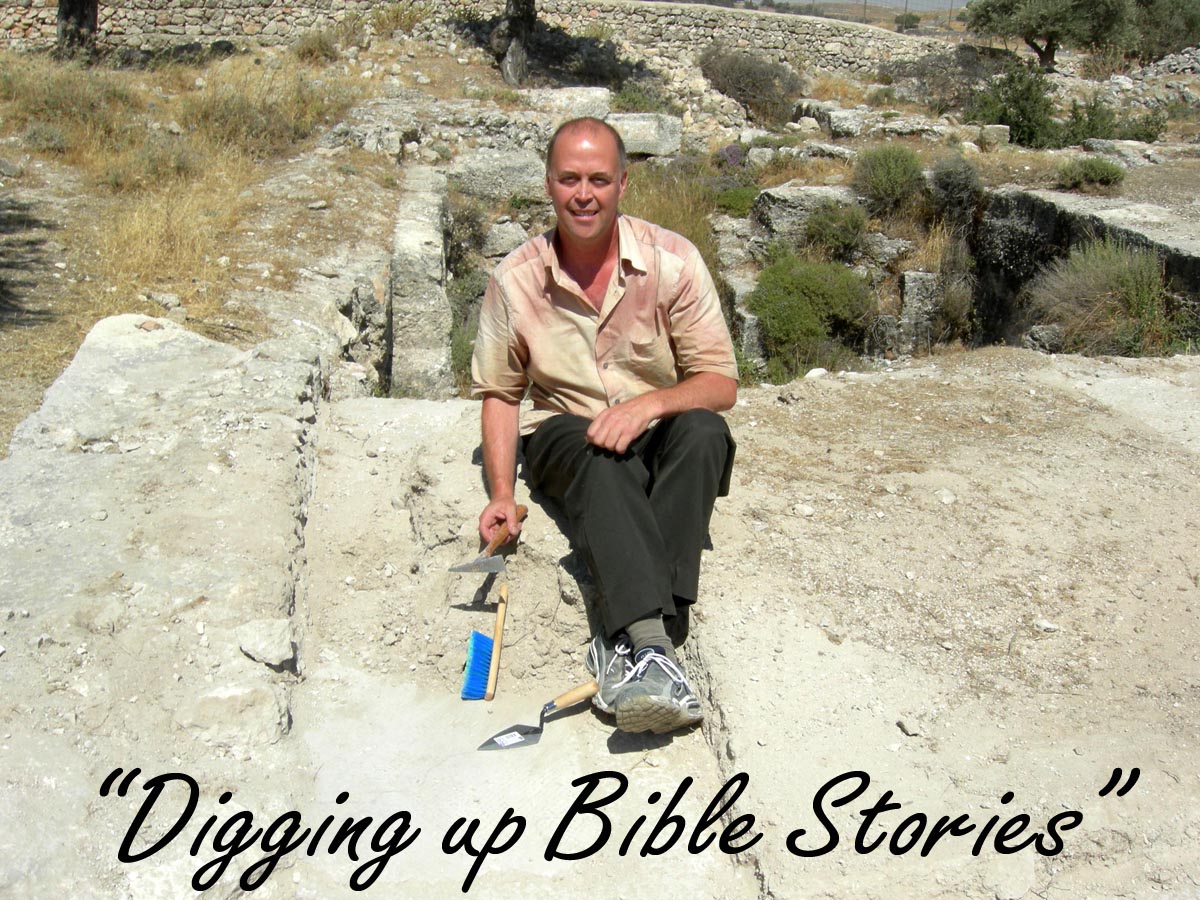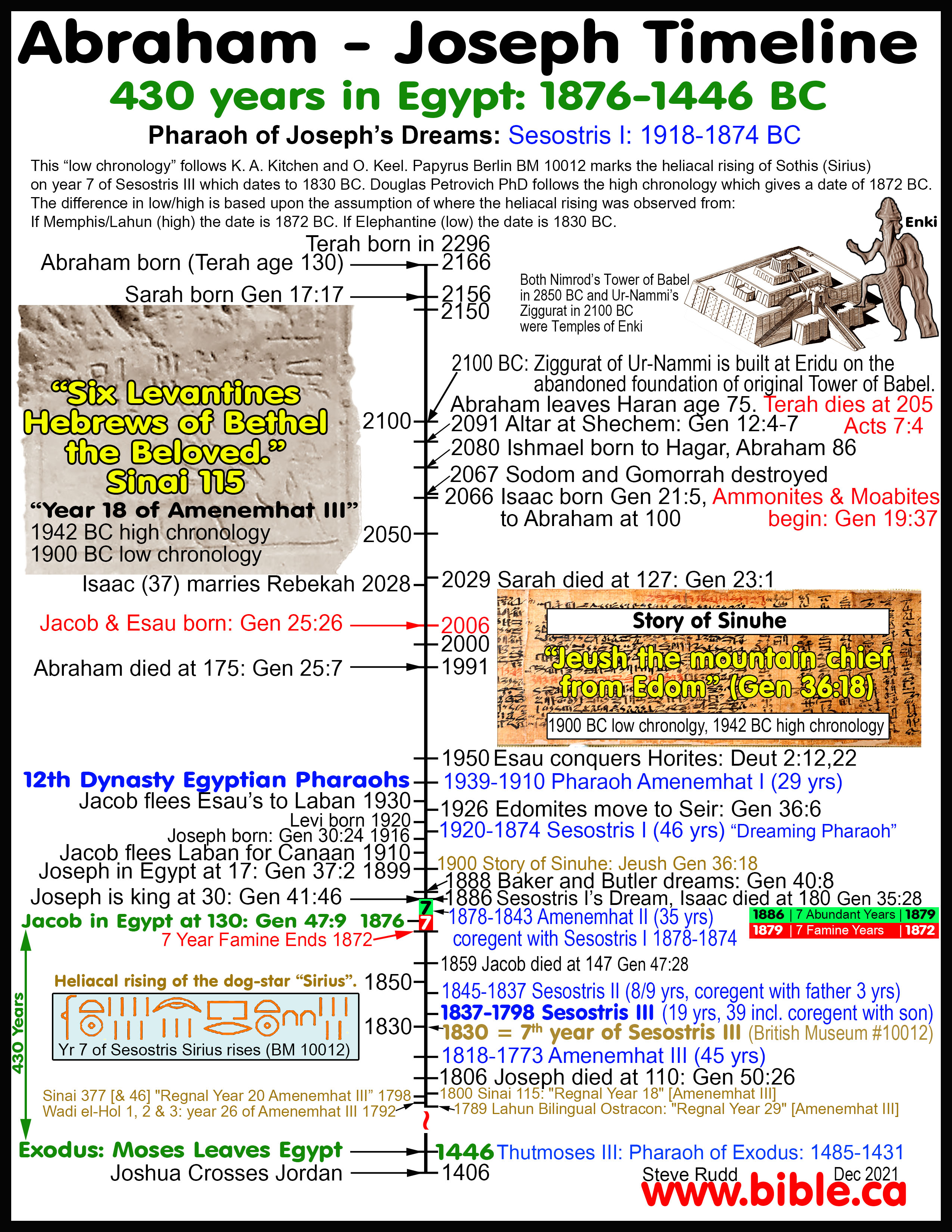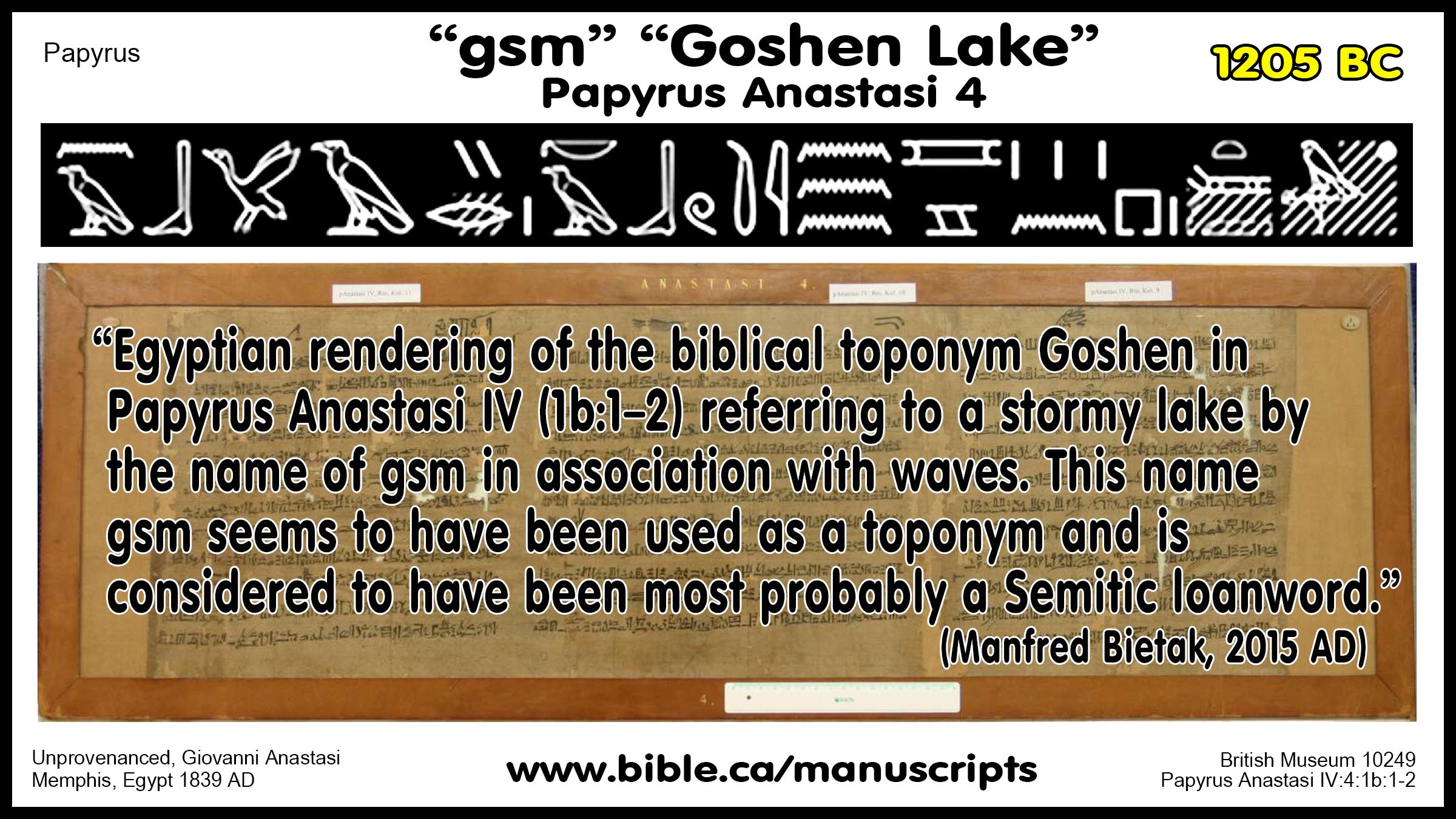Archeology of the Egyptian Oppression, Exodus and Conquest of Israel
The Moses Sinai inscription dates to 1446 BC (the year of the Exodus)
The Exodus documented in the Sinai Inscriptions
The Hebrew Oppression and Exodus Story as witnessed in the Sinai Inscriptions
|
Digging up Bible stories!
The Exodus documented in ancient inscriptions A collection of 16 previously untranslated ancient inscriptions lay in museums for 100 years but have now been translated by Dr. Doug Petrovich. The result is one of the most important archeological discoveries of all time. There are references to four Bible characters, including Moses.
"What we read in the book, we find in the ground" |
Archeological Evidence for the Egyptian Oppression, Exodus and Conquest of Israel
Introduction:
1. The amount of archeological information we possess today for the ancient history of Israel is enormous.
a. This outline is a chronological survey of the archeological evidence of the Exodus.
b. There are many other evidences not discussed herein.
2. The Oppression and Exodus Story as told by the Sinai Inscriptions
a. Starting in 1905 AD, sixteen ancient Hebrew inscriptions from Egypt were discovered by Hilda & William Matthew Flinders Petrie at four sites: Serabit el-Khadim, Wadi Nasb, Wadi el-Hol and Lahun and, 1905 AD.
b. The Petrie’s knew it was a script but were unable to decode it so they lay collecting dust for 100 years until they were translated for the first time in 2015 by Dr. Doug Petrovich.
3. See also the Conquest of Joshua, as told by the Amarna Tablets in Egyptian cuneiform.
Chronological survey of the archeological evidence
I. Abraham to Jacob: 2166-1859 BC
1. Abraham:
a. Abraham is born in 2166 BC
b. Abraham leaves Chaldea for Haran in 2091 BC (Gen 12:4)
c. Abraham visits Khirbet el Maqatir between Bethel and Ai and sets up an altar: "Then he proceeded from there to the mountain on the east of Bethel, and pitched his tent, with Bethel on the west and Ai on the east; and there he built an altar to the Lord and called upon the name of the Lord." (Genesis 12:8)
d. Abraham goes to Egypt then returns to Khirbet el Maqatir: "He went on his journeys from the Negev as far as Bethel, to the place where his tent had been at the beginning, between Bethel and Ai," (Genesis 13:3)
e. KHIRBET EL-MAQATIR: ALAR OF ABRAHAM, AI OF JOSHUA, EPHRAIM OF JESUS: Et Tel is the Ai “ruin” of Abraham located 1 km east of Khirbet el-Maqatir which was the Ai of Joshua, the first conquest city. The city of Ai of Joshua borrowed the name from Et Tel, which was a ruin at the time of Abraham as a kind of echo-morphic name. Although Ai at the time of Abraham was 1 km east of the later Ai of Joshua, Abraham was standing on the spot where the later Ai of Joshua would be founded, perhaps BECAUSE of Abraham’s altar. It is common in antiquity for a city to be destroyed and a new one is build nearby that borrows the same name. Here is a photo by the author when he excavated the Ai of Joshua (Maqatir) in 2012 AD.
f.
KHIRBET EL-MAQATIR: AI OF JOSHUA
(1446 BC): Notice the Late bronze
(1406 BC) wall that surrounded the city Joshua conquered, had later Iron I
(1200-1000 BC) walls built into it to created houses for families.
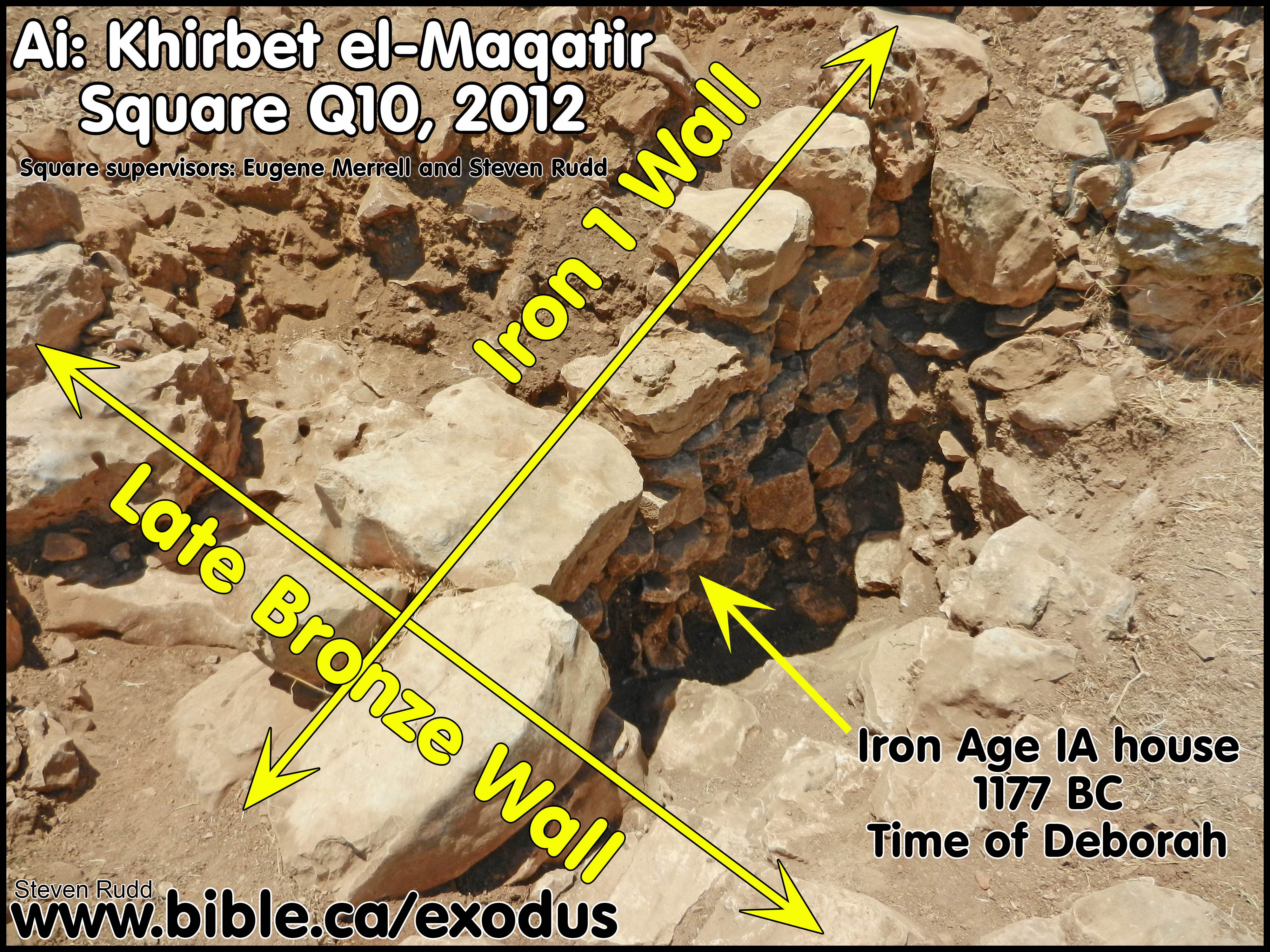
g.
KHIRBET EL-MAQATIR: EPHRAIM OF JESUS (33
AD): In the first century,
Maqatir was called Ephraim of John 11 and is where Jesus went after raising
Lazarus. Pictured below is a fenestrated wall (wall with windows) inside the
first century home at the time of Jesus. On the other side of the door and two
windows is where the animals were kept. The windows were used for supplying
feed and water without opening the door. It was a small room that would keep up
to six goats or two cows. It was in this kind of Hebrew family house where
Jesus was born “in the manger”. In first century homes, the work, cooking and
animal were on the main floor and sleeping quarters were on the second floor. See: Jesus birth. Fenestrated walls were very common in the first century. Other
excellent examples can be seen at Capernaum and Chorazin.

h. Abraham dies in 1991 BC, when Jacob is 17.
2. Jacob:
a. Jacob is born in 2006 BC
b. Jacob, age 56, is blessed by Isaac, steals Esau’s blessing then flees to Haran in 1950 BC.
c. Jacob, age 77, returns home in 1929 BC
d. Jacob establishes Bethel as his “capital city”: "So Jacob rose early in the morning, and took the stone that he had put under his head and set it up as a pillar and poured oil on its top. He called the name of that place Bethel; however, previously the name of the city had been Luz. Then Jacob made a vow, saying, “If God will be with me and will keep me on this journey that I take, and will give me food to eat and garments to wear, and I return to my father’s house in safety, then the Lord will be my God. This stone, which I have set up as a pillar, will be God’s house, and of all that You give me I will surely give a tenth to You.”" (Genesis 28:18-22)
3.
Sinai 115: “Hebrews from
Bethel”
Click on image for high resolution
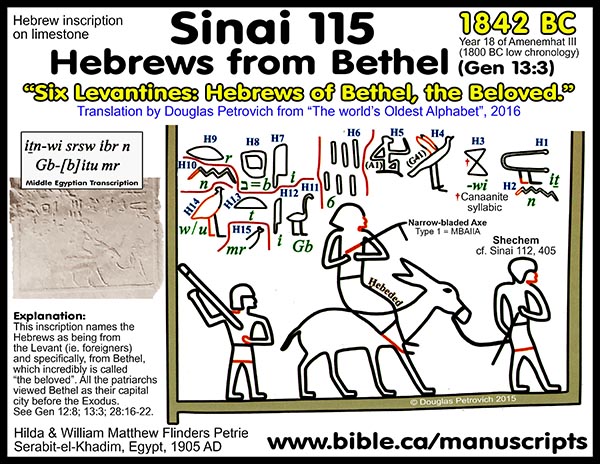
a. DATE OF SINAI 115: 1842 BC
b. TRANSLATION OF SINAI 115: “Six Levantines: Hebrews of Bethel, the Beloved.” (Translation by Douglas Petrovich from “The world’s Oldest Alphabet”, 2016 AD)
c. EXPLANATION OF SINAI 115: This inscription names the Hebrews as being from the Levant (ie. foreigners) and specifically, from Bethel, which incredibly is called “the beloved”. All the patriarchs viewed Bethel as their capital city before the Exodus. See Gen 12:8; 13:3; Gen 28:16-22
d. SUPPORTING BIBLE VERSES FOR SINAI 115: "Then Jacob awoke from his sleep and said, “Surely the LORD is in this place, and I did not know it.” He was afraid and said, “How awesome is this place! This is none other than the house of God, and this is the gate of heaven.” So Jacob rose early in the morning, and took the stone that he had put under his head and set it up as a pillar and poured oil on its top. He called the name of that place Bethel; however, previously the name of the city had been Luz. Then Jacob made a vow, saying, “If God will be with me and will keep me on this journey that I take, and will give me food to eat and garments to wear, and I return to my father’s house in safety, then the LORD will be my God. This stone, which I have set up as a pillar, will be God’s house, and of all that You give me I will surely give a tenth to You.”" (Genesis 28:16–22)
II. Joseph: 1916-1806 BC
1. Joseph is born in 1916 BC
2. In 1900 BC, a biography of Jeush, Jacob’s grandson through Esau, is written.
a. see details: Papyrus Berlin 3022.
b.
This amazing papyri is the earliest evidence of Edom
from archeology.
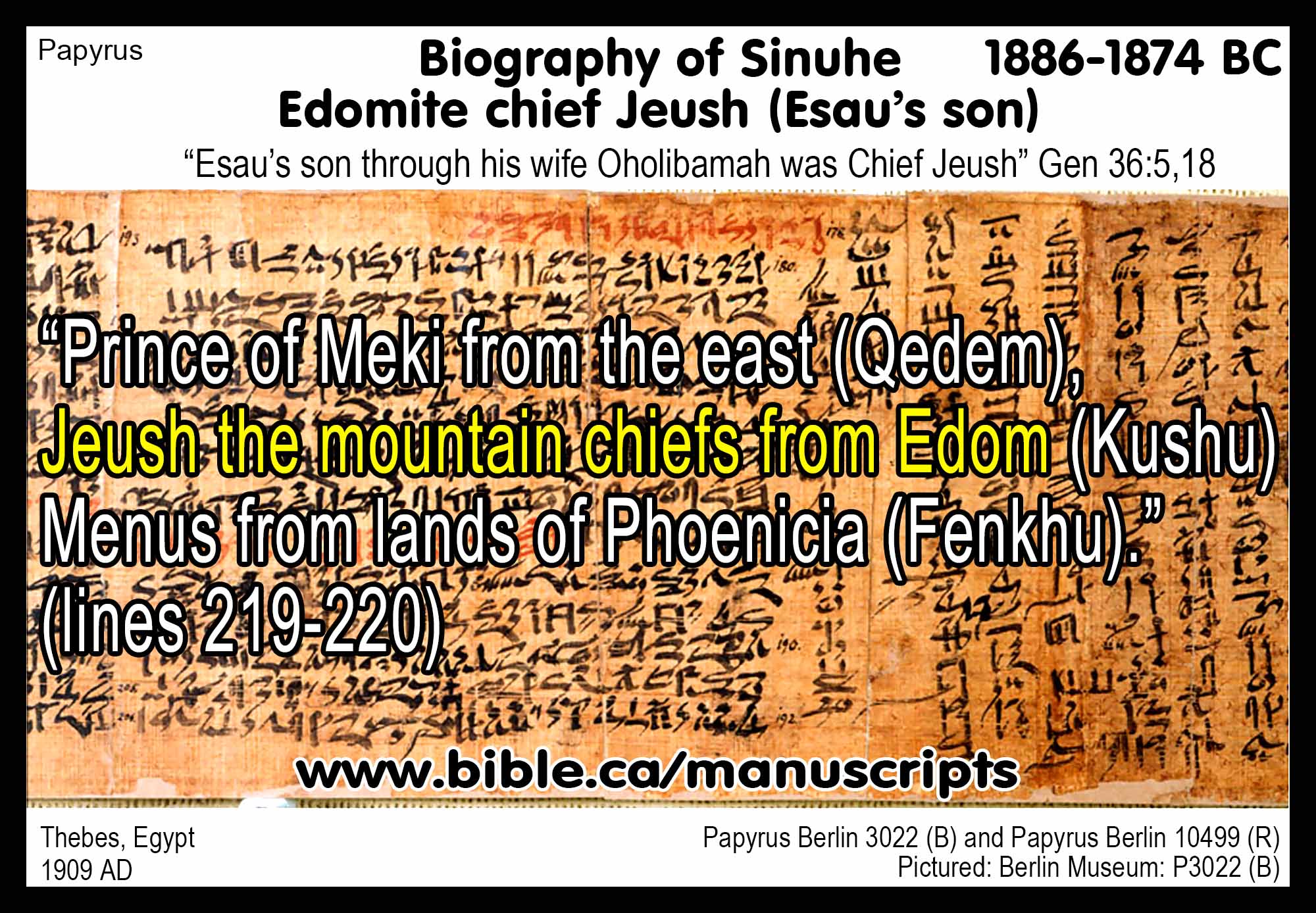
3. In 1899 BC, Joseph (Age 17) goes looking for his brothers at Shechem and finds then at Dothan.
4. At Dothan, Joseph is sold to the Ishmaelites by his brothers and enters Egypt in 1899 BC. (Gen 37:2)
5. In 1886 BC, Joseph age 30, becomes king of Egypt (second to Pharaoh), the same year Joseph’s grandfather Isaac dies at age 180.
6.
Sinai 376: Pharaoh renames Joseph and give him a wife
named Asenath. (Gen 41:45)
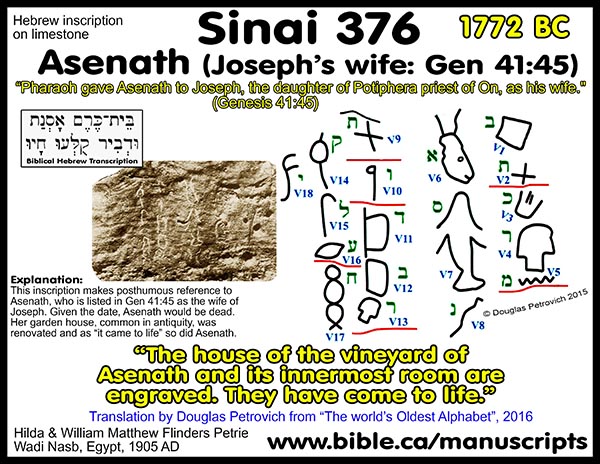
a. DATE OF SINAI 376: 1772 BC
b. TRANSLATION OF SINAI 376: “The house of the vineyard of Asenath and its innermost room are engraved. They have come to life.” (Translation by Douglas Petrovich from “The world’s Oldest Alphabet”, 2016 AD)
c. EXPLANATION OF SINAI 376: Explanation: This inscription makes posthumous reference to Asenath, who is listed in Gen 41:45 as the wife of Joseph. Given the date, Asenath would be dead. Her garden house, common in antiquity, was renovated and as “it came to life” so did Asenath.
d. SUPPORTING BIBLE VERSES FOR SINAI 376: "Then Pharaoh named Joseph Zaphenath-paneah; and he gave him Asenath, the daughter of Potiphera priest of On, as his wife. And Joseph went forth over the land of Egypt." (Genesis 41:45)
7.
In 1876 BC, Jacob’s clan of 70 move to Egypt because of
the famine.
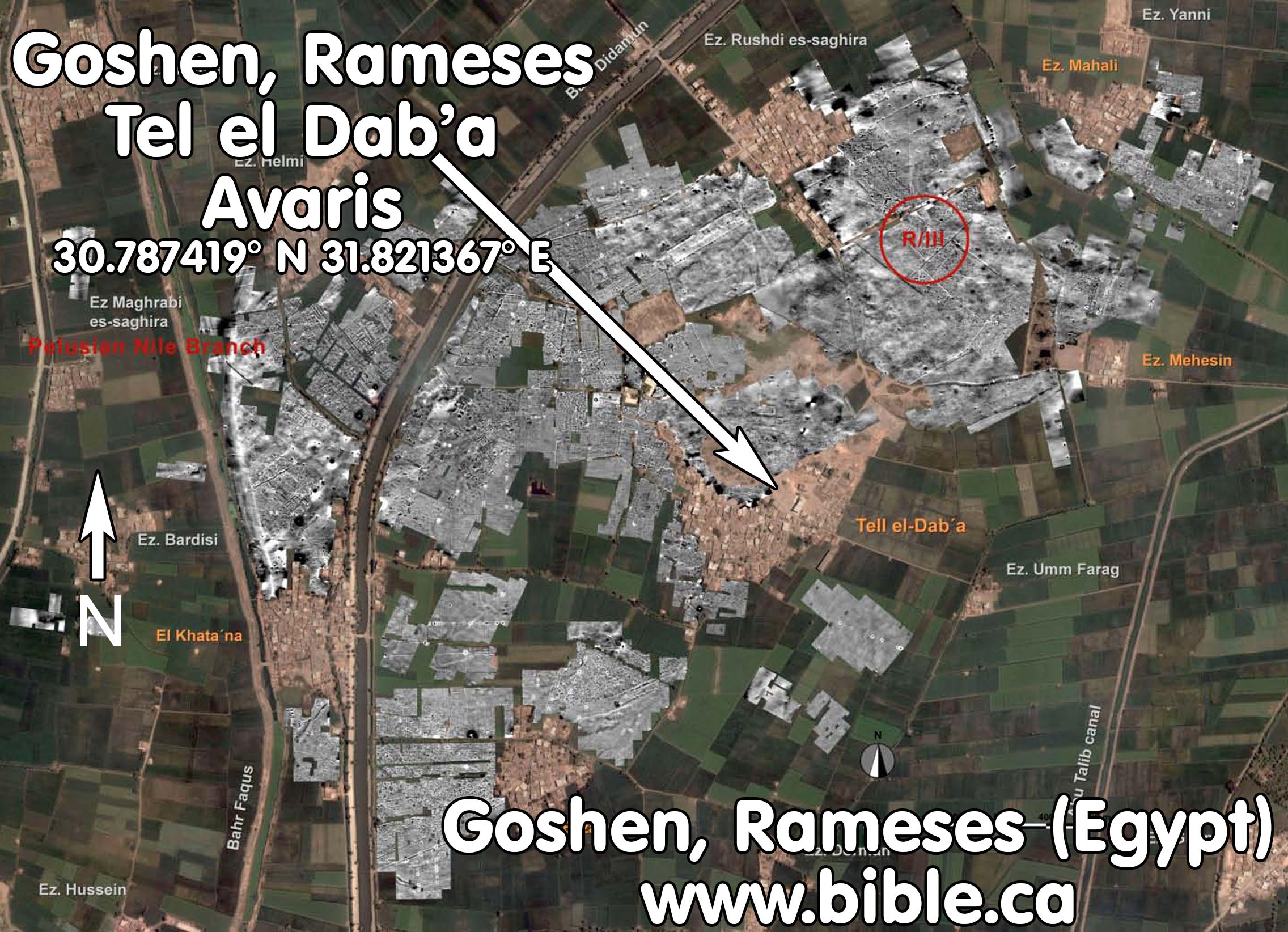
8. Jacob dies in 1859 BC and his family move to Goshen/Avaris (Tel el Daba) that same year.
9. Between 1859-1842 BC, Joseph, Ephraim and Manasseh invented the world’s first alphabet shortly after they moved to Avaris also known as the archeological site named Tel el Dab’a.
10. In 1806 BC Joseph dies.
11.
Joseph is buried in the great tomb structure at Avaris
excavated at Tel el Dab’a.
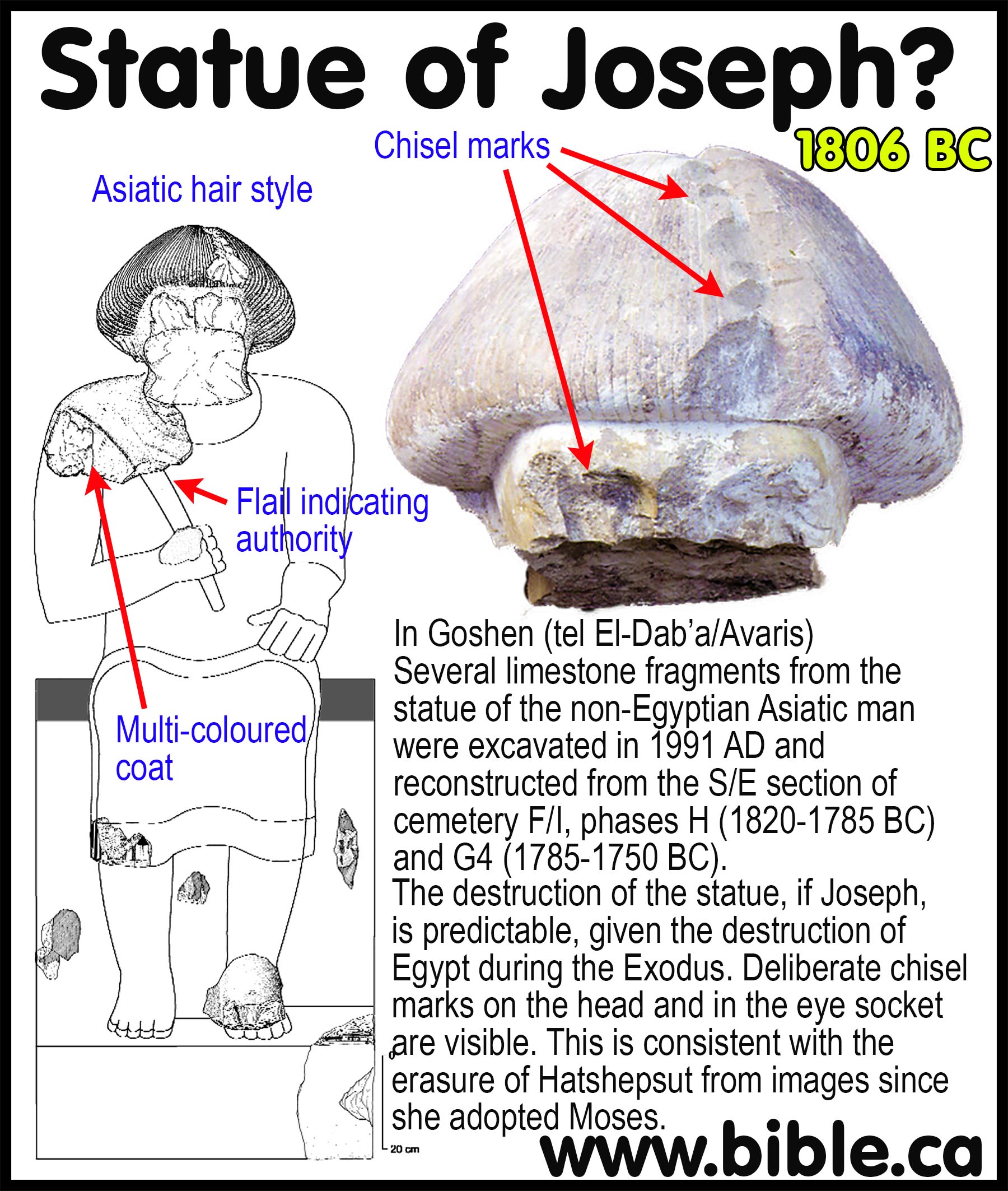
III. Period of Oppression of Israel in Egypt begins: 1556 BC:
1. Rise and expulsion of the Hyksos
a. After 100 years of ruling Egypt, the Hyksos are expelled by the 18th dynasty “Moses” pharaoh’s
b. First 18th dynasty pharaoh: Ahmoses I: 1557 – 1532 BC
c. From ancient times, Goshen (Avaris, Tel el-Dab'a) was the main shipping hub at the beginning of the “Way of Horus” coastal road north to Tyre. The Hebrews were very prosperous until the Hyksos arrived and took over the management of Avaris. Like modern port cities with millions of containers being loaded and offloaded from ocean tanker ships, Avaris needed huge storage areas for all the goods. The Hyksos were expelled by the 18th dynasty Pharaohs of Egypt who “Knew not Joseph”. The Hebrews were stripped of their financial control and became oppressed slaves who built two storage cities of Pithom and Raamses (Ex 1:11).
d. Ahmoses I (1557-1532 BC) was only 10 years old when he ascended the throne after the death of his brother. Excavations at Tel el Dab’a (Avaris) by Bietak and synchronisms with day book entry in year 11 of Khamudi (the last Hyksos king) in the Rhind Mathematical Papyrus indicate the Hyksos were finally defeated at Avaris in the 15th year of Ahmoses I in 1542 BC. This seems to be confirmed by records of Ahmoses I first military campaigns which began after his 10th regnal year in 1547 BC at age 20. Inscriptions on the wall of a cliff-tomb at El Kab, located 100 km south of Luxor, of a naval officer named Ahmoses (who served under three pharaohs: Ahmoses I, Amenhotep I, and Thutmose I,) contains the biography of Ahmoses I. The El Kab inscription records a sequence of three successive sieges of Avaris that were interrupted by a Nubian offensive which was defeated. Avaris finally fell after the 4th attack. Khamudi, the defeated Hyksos king then fled from Avaris to the biblical city of Sharuhen (Joshua 19:6) in the Simeon Negev where the inscription records a six-year siege until Sharuhen finally fell in the 31st regnal year (1536 BC). This marks the end and final expulsion of the Hyksos by Ahmoses I. The inscription then records the first foreign offensive campaign south into Nubia against the Troglodytes and two successive counter attacks that were defeated. Another inscription found in the ancient Egyptian mining town of Tura located 15 km south of Cairo on the east bank of the Nile, indicate the latest possible date for the defeat of the Hyksos was in the 22nd regnal year of Ahmoses I. “Ahmoses must have conquered Avaris by [sometime before] the 18th or 19th year of his reign. This is suggested by a graffito in the quarry at Tura whereby, “oxen from Canaan were used at the opening of the quarry” in Ahmoses’s regnal year 22. Since the cattle would probably have been imported after Ahmoses’s siege of the town of Sharuhen, which followed the fall of Avaris, this means that the reign of Khamudi must have terminated by year 18 or 19 of Ahmoses’ 25-year reign at the very latest.” (Egypt, Canaan, and Israel in Ancient Times, Redford, Donald, Bronze Age Collapse, Ch 8, 1992 AD)
2. Sinai 349: The Egyptians are in great fear of the huge Hebrew population
a. "Come, let us deal wisely with them, or else they will multiply and in the event of war, they will also join themselves to those who hate us, and fight against us and depart from the land.”" (Exodus 1:10)
b. The Egyptians didn’t fear a Hebrew coup, instead they feared all the Hebrews would LEAVE EGYPT and their life of luxury would be over.
c. See Sinai 349 below as direct confirmation of the Bible narrative that the Egyptians feared the huge Hebrew population and therefore enslaved them with hard labour.
3. Moses: is born in 1526 BC
a. Pharaoh who killed Hebrew children: Amunhotep I: 1532-1511 BC
b. Pharaoh's Daughter who adopted Moses: Hatshepsut: 1526 BC
c. Pharaoh of Moses' flight to Midian in 1486 BC: Thutmoses II/Hatshepsut: 1498-1485 BC
d. Pharaoh of the Exodus: Thutmoses III: 1485/1464 - 1431 BC
IV. The Sinai inscriptions of the Hebrew oppression in Egypt:
1.
Sinai 349: Oppression
because Egyptians feared the huge Hebrew population
Click on image for high resolution

a. DATE OF SINAI 349: 1480 BC
b. TRANSLATION OF SINAI 349: “He Sought occasion to cut away to barrenness our great number, our swelling without measure They yearned for Hathor, but the quiver of our brothers was thoroughly despised, so he performed terror against their quiver and brought about a cry of wailing.” (Translation by Douglas Petrovich from “The world’s Oldest Alphabet”, 2016 AD)
c. EXPLANATION OF SINAI 349: This amazing inscription actually confirms the Bible directly that the Egyptians feared the rising population of the Hebrews while in Egypt. This inscription is part of a collection of pessimistic and negative texts. See also Sinai 357, 353, 360. Given the dating of 1480 BC, it is a perfect match for the oppression of the Hebrews by the Egyptians who feared their large population. See Exodus 1:8-10. They called upon Hathor, the cow goddess, but she failed to protect them from the king of Egypt: “He performed terror against their quiver and brought about a cry of wailing”.
d. SUPPORTING BIBLE VERSES FOR SINAI 349: "Now a new king arose over Egypt, who did not know Joseph. He said to his people, “Behold, the people of the sons of Israel are more and mightier than we. Come, let us deal wisely with them, or else they will multiply and in the event of war, they will also join themselves to those who hate us, and fight against us and depart from the land.”" (Exodus 1:8-10)
2. Sinai 357: The King of Egypt has cursed, surrounded and depleted the Hebrews.
a.
Click on image for high
resolution
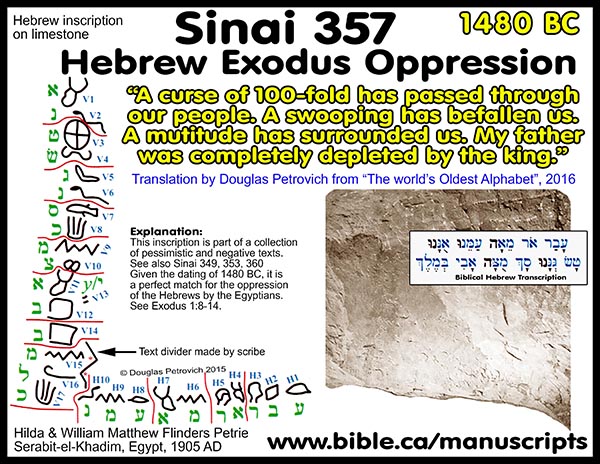
b. DATE OF SINAI 357: 1480 BC
c. TRANSLATION OF SINAI 357: “A curse of 100-fold has passed through our people. A swooping has befallen us. A mutitude has surrounded us. My father was completely depleted by the king.” (Translation by Douglas Petrovich from “The world’s Oldest Alphabet”, 2016 AD)
d. EXPLANATION OF SINAI 357: This inscription is part of a collection of pessimistic and negative texts. See also Sinai 349, 353, 360 Given the dating of 1480 BC, it is a perfect match for the oppression of the Hebrews by the Egyptians.
e. SUPPORTING BIBLE VERSES FOR SINAI 357: " "Now a new king arose over Egypt, who did not know Joseph. He said to his people, “Behold, the people of the sons of Israel are more and mightier than we. Come, let us deal wisely with them, or else they will multiply and in the event of war, they will also join themselves to those who hate us, and fight against us and depart from the land.” So they appointed taskmasters over them to afflict them with hard labor. And they built for Pharaoh storage cities, Pithom and Raamses. But the more they afflicted them, the more they multiplied and the more they spread out, so that they were in dread of the sons of Israel. The Egyptians compelled the sons of Israel to labor rigorously; and they made their lives bitter with hard labor in mortar and bricks and at all kinds of labor in the field, all their labors which they rigorously imposed on them." (Exodus 1:8–14)
3.
Sinai 360: The “pruned”
Hebrews have a very bad year.
Click on image for high resolution
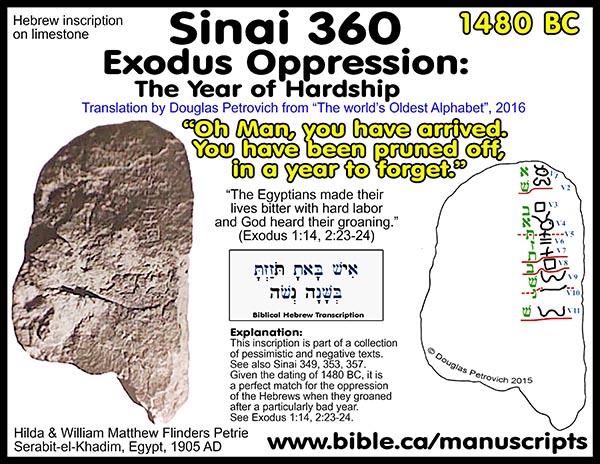
a. DATE OF SINAI 360: 1480 BC
b. TRANSLATION OF SINAI 360: “Oh Man, you have arrived. You have been pruned off, in a year to forget.” (Translation by Douglas Petrovich from “The world’s Oldest Alphabet”, 2016 AD)
c. EXPLANATION OF SINAI 360: This inscription is part of a collection of pessimistic and negative texts. See also Sinai 357, 349, 360. Given the dating of 1480 BC, it is a perfect match for the oppression of the Hebrews when they groaned after a particularly bad year. See Exodus 1:14, 2:23-24.
d. SUPPORTING BIBLE VERSES FOR SINAI 360: "Now it came about in the course of those many days that the king of Egypt died. And the sons of Israel sighed because of the bondage, and they cried out; and their cry for help because of their bondage rose up to God. So God heard their groaning; and God remembered His covenant with Abraham, Isaac, and Jacob. God saw the sons of Israel, and God took notice of them." (Exodus 2:23–25)
4.
Sinai 353: The oppressed and hopeless Hebrews call upon
Egyptian sun god for deliverance.
Click on image for high
resolution

a. DATE OF SINAI 353: 1480 BC
b. TRANSLATION OF SINAI 353: “It is a time to be hopeless. The Lady (Baalath) had organized for battle. We banded together to remain with heads held high. We celebrated a festival of the sun, which came out in order to hold us back.” (Translation by Douglas Petrovich from “The world’s Oldest Alphabet”, 2016 AD)
c. EXPLANATION OF SINAI 353: This inscription is part of a collection of pessimistic texts. See Sinai 357, 349, 360. Their worship of Baalath failed to protect them, (see Sinai 345) so they worshipped one of the Egyptian sun gods. At Sinai Israel reverted to worshipping Baalath as the golden calf (cow goddess Hathor) whom they wrongly believed defeated Egypt on their behalf See Ex 32; Neh 9:18; Acts 7:41.
d. SUPPORTING BIBLE VERSES FOR SINAI 353:
i. "Now when the people saw that Moses delayed to come down from the mountain, the people assembled about Aaron and said to him, “Come, make us a god who will go before us; as for this Moses, the man who brought us up from the land of Egypt, we do not know what has become of him.” Aaron said to them, “Tear off the gold rings which are in the ears of your wives, your sons, and your daughters, and bring them to me.” Then all the people tore off the gold rings which were in their ears and brought them to Aaron. He took this from their hand, and fashioned it with a graving tool and made it into a molten calf; and they said, “This is your god, O Israel, who brought you up from the land of Egypt.” Now when Aaron saw this, he built an altar before it; and Aaron made a proclamation and said, “Tomorrow shall be a feast to the Lord.” So the next day they rose early and offered burnt offerings, and brought peace offerings; and the people sat down to eat and to drink, and rose up to play. Then the Lord spoke to Moses, “Go down at once, for your people, whom you brought up from the land of Egypt, have corrupted themselves. They have quickly turned aside from the way which I commanded them. They have made for themselves a molten calf, and have worshiped it and have sacrificed to it and said, ‘This is your god, O Israel, who brought you up from the land of Egypt!’ ” The Lord said to Moses, “I have seen this people, and behold, they are an obstinate people. Now then let Me alone, that My anger may burn against them and that I may destroy them; and I will make of you a great nation.”" (Exodus 32:1–10)
ii. "And I saw that you had indeed sinned against the Lord your God. You had made for yourselves a molten calf; you had turned aside quickly from the way which the Lord had commanded you." (Deuteronomy 9:16)
iii. "“Even when they made for themselves A calf of molten metal And said, ‘This is your God Who brought you up from Egypt,’ And committed great blasphemies," (Nehemiah 9:18)
iv. "They made a calf in Horeb and worshiped a molten image." (Psalm 106:19)
v. "At that time they made a calf and brought a sacrifice to the idol, and were rejoicing in the works of their hands." (Acts 7:41)
V. The Exodus: Moses Sinai Inscription:
1. Pharaoh of the Exodus: Thutmoses III: 1485/1464 - 1431 BC
2. Succoth was the only stop between Goshen and the Red Sea crossing at the Straits of Tiran.
3.
Sinai 361: The Moses inscription
Click on image for high resolution
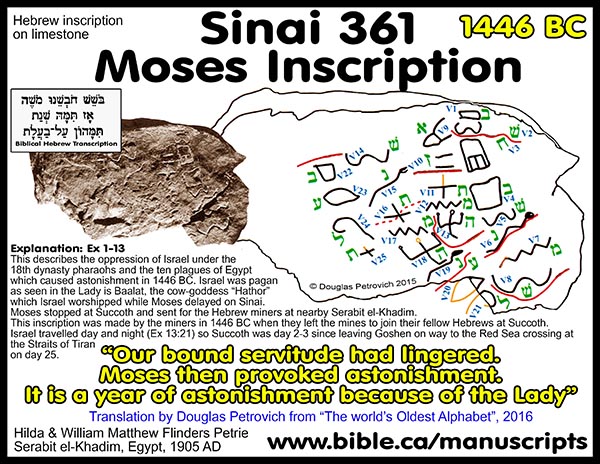
a. DATE OF SINAI 361: 1446 BC
b. TRANSLATION OF SINAI 361: (Translation by Douglas Petrovich from “The world’s Oldest Alphabet”, 2016 AD)
c. EXPLANATION OF SINAI 361: This describes the oppression of Israel under the 18th dynasty pharaohs and the ten plagues of Egypt which caused astonishment in 1446 BC. Israel was pagan as seen in the Lady is Baalat, the cow-goddess “Hathor” which Israel worshipped while Moses delayed on Sinai. While in previous inscriptions, Israel blamed Baalat for their oppression, now they are attributing the defeat of Egypt and the plagues to Baalat. Moses stopped at Succoth and sent for the Hebrew miners at nearby Serabit el-Khadim. This inscription was made by the miners in 1446 BC when they left the mines to join their fellow Hebrews at Succoth. Moses would have sent a message of freedom to the miners much like Noah and Jesus Christ! They crossed the Red Sea at the Straits of Tiran on the gulf of Aqaba on day 25 after leaving Egypt. Remember the Israelites travelled day and night, so the Succoth stop was likely day 2-3 after they left Goshen.
d. SUPPORTING BIBLE VERSES FOR SINAI 361: "
i. "Now the sons of Israel journeyed from Rameses to Succoth, about six hundred thousand men on foot, aside from children." (Exodus 12:37)
ii. "Then they set out from Succoth and camped in Etham on the edge of the wilderness. The Lord was going before them in a pillar of cloud by day to lead them on the way, and in a pillar of fire by night to give them light, that they might travel by day and by night. He did not take away the pillar of cloud by day, nor the pillar of fire by night, from before the people." (Exodus 13:20–22)
VI. Mount Sinai and two Sinai Inscriptions:
1. Red sea crossing: Straits of Tiran on the gulf of Aqaba crossing on day 25
2. Mt. Sinai: Jebel/Mt. Lawz in Saudi Arabia arriving on day 45 spending 11 months
3.
Sinai 345: The Rosetta
Sphynx: Israel worships Hathor the cow goddess
Click on image for high resolution

a. DATE OF SINAI 345: BC
b. TRANSLATION OF SINAI 345: “He who is loved by the Lady” [Lady = Baalath = Hathor] (Translation by Douglas Petrovich from “The world’s Oldest Alphabet”, 2016 AD)
c. EXPLANATION OF SINAI 345: We call this bilingual inscription “The Rosetta Sphynx” because it has identical inscriptions in Middle Egyptian and Hebrew is part of a collection. It proves that the Hebrews worshipped Hathor before Sinai and was Aaron’s golden Calf: Ex 32:24. We have seen in Sinai 252 that Israel blamed Baalath for the Egyptian oppression and in Sinai 361 Israel praised Baalath for liberation from the Egyptians. There are several additional Sinai inscriptions in Doug Petrovich’s book we did not include here that show Israel absolutely worshipped Baalath. At Mt. Sinai Israel’s golden calf was none other than Baalath, the female cow deity.
d. SUPPORTING BIBLE VERSES FOR SINAI 345: Aaron said to Moses: “I threw the gold in the fire and out popped this calf.” (Exodus 32:24)
4.
Sinai 375a: Ahisamach,
the father of Oholiab, named as overseer of minerals: Ex 31:6
Click on image for high resolution

a. DATE OF SINAI 375a: 1480 BC
b. TRANSLATION OF SINAI 375a: “The overseer of Minerals, Ahisamach” (Translation by Douglas Petrovich from “The world’s Oldest Alphabet”, 2016 AD)
c. EXPLANATION OF SINAI 375a: This inscription names Ahisamach, a master craftsman at the turquoise mines. His son, Oholiab had learned the skill from his father and was chosen to be filled with the supernatural gift of the Holy Spirit of knowledge and wisdom. Notice the text says that those who were already skilled, would be given supernatural skill, in order to build the tabernacle furniture like the ark of the covenant. Just as the church began with the supernatural indwelling of the Holy Spirit, so too did the law of Moses. The same thing happened on Pentecost in AD 33 when the twelve apostles were filled with the same indwelling of the Holy Spirit. The Bible text says that God sent the Holy Spirit on Hebrews who already possessed great skill as craftsman, then names Oholiab, the son of the boss at the mining operations at Serabit el-Khadim. It just doesn’t get any more amazing than that! What you read in the book you find in the ground!
d. SUPPORTING BIBLE VERSES FOR SINAI 375a:
i. "Now the Lord spoke to Moses, saying, “See, I have called by name Bezalel, the son of Uri, the son of Hur, of the tribe of Judah. I have filled him with the Spirit of God in wisdom, in understanding, in knowledge, and in all kinds of craftsmanship, to make artistic designs for work in gold, in silver, and in bronze, and in the cutting of stones for settings, and in the carving of wood, that he may work in all kinds of craftsmanship. And behold, I Myself have appointed with him Oholiab, the son of Ahisamach, of the tribe of Dan; and in the hearts of all who are skillful I have put skill, that they may make all that I have commanded you: the tent of meeting, and the ark of testimony, and the mercy seat upon it, and all the furniture of the tent, the table also and its utensils, and the pure gold lampstand with all its utensils, and the altar of incense, the altar of burnt offering also with all its utensils, and the laver and its stand, the woven garments as well, and the holy garments for Aaron the priest, and the garments of his sons, with which to carry on their priesthood; the anointing oil also, and the fragrant incense for the holy place, they are to make them according to all that I have commanded you.”" (Exodus 31:1–11)
ii. "Then Moses said to the sons of Israel, “See, the Lord has called by name Bezalel the son of Uri, the son of Hur, of the tribe of Judah. And He has filled him with the Spirit of God, in wisdom, in understanding and in knowledge and in all craftsmanship; to make designs for working in gold and in silver and in bronze, and in the cutting of stones for settings and in the carving of wood, so as to perform in every inventive work. He also has put in his heart to teach, both he and Oholiab, the son of Ahisamach, of the tribe of Dan. He has filled them with skill to perform every work of an engraver and of a designer and of an embroiderer, in blue and in purple and in scarlet material, and in fine linen, and of a weaver, as performers of every work and makers of designs." (Exodus 35:30–35)
iii. "Now there are varieties of gifts, but the same Spirit. And there are varieties of ministries, and the same Lord. There are varieties of effects, but the same God who works all things in all persons. But to each one is given the manifestation of the Spirit for the common good. For to one is given the word of wisdom through the Spirit, and to another the word of knowledge according to the same Spirit; to another faith by the same Spirit, and to another gifts of healing by the one Spirit, and to another the effecting of miracles, and to another prophecy, and to another the distinguishing of spirits, to another various kinds of tongues, and to another the interpretation of tongues. But one and the same Spirit works all these things, distributing to each one individually just as He wills." (1 Corinthians 12:4–11)
VII. Archeological evidence of Israel in Egypt: Lake Goshen
1. Goshen included Wadi Tumilat and lake Timsah:
a. “But even more conclusive than this is the situation in Goshen during the reign of Thutmose III as compared to that which existed under Rameses II. In the time of Rameses, some of his main building activity was right in the region of Wadi Tumilat, or Goshen, and this meant that Egyptians must have been living all around this region and in the midst of it as well. But the details of the plagues of flies, of hail, and of darkness (Ex. 8:22; 9:25–26; 10:23) make it clear enough that Goshen was at the time of the Exodus inhabited almost exclusively by the Hebrews, and plagues which befell the rest of Egypt made no appearance at all in Goshen. So far as we can tell from the archaeological evidence presently at hand, there were no Egyptians living there during the reign of Thutmose.” (A Survey of Old Testament Introduction, Gleason Archer, p246, 1994 AD)
b. “Leaving the Negeb at Beer-sheba (Gen. 46:1), Jacob and his sons journeyed across the Sinai entering Egypt near Succoth in the Wadi Tumilat. Asiatic shepherds and merchants coming from southern Canaan and Transjordan used this route extensively. The family entered the “land of Goshen” (Gen. 46:28; 47:6), once anachronistically called the “land of Rameses” (Gen. 47:11), located in the northeastern Delta of Egypt. Some scholars have identified Goshen more specifically with the Wadi Tumilat, a fertile finger of the Delta jutting out into the Sinai Desert.” (Holman Bible Atlas, p50, 1998 AD)
c. “The Septuagint clearly identified the land of Goshen and the route of the Exodus with the Wadi Tumilat. … Another interpretation of the Exodus route in the Septuagint (Exod. 1:11)—originally most likely to be a gloss that found its way into the main text—seems to lead from Heliopolis, thought to be Pithom (Pi-Atum), to the Gulf of Suez and the Red Sea.” (On the Historicity of the Exodus: What Egyptology Today Can Contribute to Assessing the Biblical Account of the Sojourn in Egypt, Manfred Bietak, Israel's Exodus in Transdisciplinary Perspective, Editor-Thomas E. Levy, p21, 2015 AD)
d. “During prehistoric times (before 3200 BC), the Nile’s easternmost branch once passed through the Wadi Tumilat. Stretching 31 mi (52 km) from just west of modern Zagazig (ancient Bubastis) to Ismailiya (on Lake Timsah), it created a portion of the eastern edge of the Nile delta. While the course of this delta branch disappeared in historic times, and the present eastern branch is significantly further to the west, both historical and archaeological evidence indicate that ancient canals were cut from the Nile River eastward through the Wadi Tumilat. This ancient watercourse apparently continued to flood periodically throughout history with the overflow of the Nile’s annual flooding. Thus, the Wadi Tumilat may have been one of the reasons that the Isthmus of Suez became known for its marshy fresh water lakes and associated “reeds” (twf). The Wadi Tumilat was no doubt part of the Biblical Land of Goshen.” (New Evidence From Egypt on the Location of the Exodus Sea Crossing, Gary Byers, Bible and Spade, p19, 2006 AD)
e. “There are areas at the eastern borders of Egypt that had Semitic toponyms used even by Egyptian scribes. This situation can only be reasonably explained by assuming that Semitic-speaking people inhabited such areas during the New Kingdom. One has to mention particularly in this respect Wadi Tumilat, which would fulfill in every respect the model of the land of Goshen (or the land of Ramses) in the Bible.” (On the Historicity of the Exodus: What Egyptology Today Can Contribute to Assessing the Biblical Account of the Sojourn in Egypt, Manfred Bietak, Israel's Exodus in Transdisciplinary Perspective, Editor-Thomas E. Levy, p30, 2015 AD)
2. Goshen was centered at “Lake Goshen” or the “Lakes of Pithom” in the Wadi Ṭumilât:
a. “One wonders if under such evidence Wadi Tumilat could not be deemed, with all due reservation, a paradigm for the biblical scenario of the land of Goshen (Gen. 45:10; 46:28–29, 34; 47:1, 4, 6, 27; 50:8; Exod. 8:18; 9:26). Indeed, Sarah I. Groll cautiously postulated the identification of a possible Egyptian rendering of the biblical toponym Goshen in Papyrus Anastasi IV (1b:1–2) referring to a stormy lake by the name of gsm in association with waves. This name gsm seems to have been used as a toponym and is considered to have been most probably a Semitic loanword. It is in this connection that it is most important to note that, in the Septuagint translation of the Pentateuch into Greek, this name seems to be retained as Γεσεμ (Gesem). The lake must have been a wide stretch of water. This would fit in perfectly with the western part of Wadi Tumilat with its large overflow lake.” (On the Historicity of the Exodus: What Egyptology Today Can Contribute to Assessing the Biblical Account of the Sojourn in Egypt, Manfred Bietak, Israel's Exodus in Transdisciplinary Perspective, Editor-Thomas E. Levy, p21, 2015 AD)
b. see also: Groll Sarah, Israelit. 1998. The Egyptian Background of the Exodus and the Crossing of the Reed Sea: A New Reading of Papyrus Anastasi VIII. In Jerusalem Studies in Egyptology, A¨ AT, vol. 40, ed. I. Shirun- Grumach, 173–192. Wiesbaden: O. Harrassowitz.
c. “The Israelites were settled in the Land of Goshen, in a region which perhaps extended further northward, but which certainly comprehended the Wadi Tumilât, wherein was situate the city of Pithom, where, according to the Septuagint, Jacob and Joseph met when the Patriarch came to Egypt.” (The Store-City of Pithom and the Route of the Exodus, Edouard Naville, p23, 1885 AD)
3. Papyrus Anastasi 6:4.11–6.5 (VI.4):
a. “We have allowed the tribes of the Shasu of the land of Atuma to pass the stronghold of King Menephtah of the land of Succoth, towards the lakes of Pithom of King Menepthah of the land of Succoth, in order to feed their cattle in the great farm of Pharaoh,” (Papyrus Anastasi vi. 4)
b. “More in keeping with the biblical tradition is the oft-discussed event described in Papyrus Anastasi VI (4.11–6.5) in which a group of Shosu Bedouins from Edom is granted permission by the Egyptian authorities to pass the border stronghold in the region of Tjeku in what is today the Wadi Tumilat and to proceed with their livestock to the Lakes of Pithom to keep their flocks alive (Gardiner 1937: 76–77; Caminos 1954: 293–295; Giveon 1971: 131–134). This papyrus dates back to the end of the thirteenth century BC, more precisely to the fifth year of Sethos (Seti) II (ca. 1209 BC). These people should not be taken as Edomites, but as Shosu from Edom. As Yahweh is said to have risen in Seı¨r in Edom (Deut. 33:2; Ju. 5:4; see also Habakuk 3:3) these pastoralists appear at the right time and from the right corner to be considered the gene pool of Midianites or Proto- Israelites.17 Nevertheless the incident described in this papyrus can only be seen as a symptomatic event, recorded and preserved by accident as a template record for apprentice scribes. However, one has to wonder in this context why the toponym the “Lakes of Pithom” is referred to by Egyptian scribes with the Semitic loanword b-r-k-w.t in syllabic writing and not with its Egyptian name. This is indeed remarkable. We gain the suspicion that this word had become something of a toponym in a region inhabited long enough by a Semitics peaking population to supplant the original Egyptian name with an idiomatic expression of their own. In support of this proposition, the point needs to be made that, in the Onomasticon Amenope (Amenemopet), word no. 33 b-r-k-t is followed by no. 34 hnty(w) “borderland,” “frontier”— which would be a meaningful association. Furthermore another Semitic expression s-g-r is used for an enclosure or a fortification of a fortress in the same region (papyri Anastasi V.19, 7). Even Tjeku, the name of the region of Wadi Tumilat, is regarded by many as an Egyptian rendering of the biblical Sukkot. All of this could be viewed as some evidence that this borderland had been settled by a Semitic-speaking population.” (On the Historicity of the Exodus: What Egyptology Today Can Contribute to Assessing the Biblical Account of the Sojourn in Egypt, Manfred Bietak, Israel's Exodus in Transdisciplinary Perspective, Editor-Thomas E. Levy, p20, 2015 AD)
c. “During an investigation of the paleogeography of the Eastern Delta (Bietak 1975: 88–90) it was discovered in topographic contour maps that the western part of Wadi Tumilat, just west of Tell el-Retaba was in antiquity the basin of a large natural overflow lake of 18 km length and 1.8 km width. It must have been a stretch of water that was suitable for fishing. Only now does it become understandable why this lake was eponymous and had given its name to this region as “Eastern Harpoon Nome” (for the nomes, see Helck 1974: 172–4) from the time of the Old Kingdom onwards. This lake was fed by a side branch of the easternmost Nile branch. In late Ramesside times it seems, according to information from Papyrus Anastasi VI: 4:11–6:5, that the lake had ramified into several smaller lakes (plural b-r-k-A-w.t), most likely owing to a reduced water intake or sedimentation. The contours of the Wadi basin indeed show a separation of the lake into subunits by accumulation of ridges of sediments. The description of those waters is written with a Semitic loanword in syllabic writing: b-r-k- A-w.t. The modern translation influenced by Hebrew בְּרֵכוֹת “pools” or “water reservoirs” must be assumed wrong, not only because of the paleoenvironment explained above. In the onomastic Papyrus Golenischeff 1.9–10 the b-r-k-A-w.t are associated with and directly follow the expression nwy “wave” (Wo¨rterbuch, lemma no. 56570, DZA 22.903.660). What is more, the Demotic Fayum Papyrus (Papyruszettel 7 or 7a) mentions a toponym b-r-g-t with the compound classifiers of a channel signifying a stretch of water and the town. It has been pinpointed as a habitat of the crocodile and is most probably the precursor of the Birket Qarun in the Fayum (DZA 22.903.700). A pool is significant neither for making distinct waves nor as a habitat for crocodiles. I would venture to translate this loanword, as in the Arabic “birka,” as a lake, and thus a larger body of water, as paleogeographic studies have shown for the western portion of Wadi Tumilat. I am grateful to Orly Goldwasser from the Hebrew University in Jerusalem for helping me with the research into this loanword.” (On the Historicity of the Exodus: What Egyptology Today Can Contribute to Assessing the Biblical Account of the Sojourn in Egypt, Manfred Bietak, Israel's Exodus in Transdisciplinary Perspective, Editor-Thomas E. Levy, p21, fn 14, 2015 AD)
a. “One wonders if under such evidence Wadi Tumilat could not be deemed, with all due reservation, a paradigm for the biblical scenario of the land of Goshen (Gen. 45:10; 46:28–29, 34; 47:1, 4, 6, 27; 50:8; Exod. 8:18; 9:26). Indeed, Sarah I. Groll cautiously postulated the identification of a possible Egyptian rendering of the biblical toponym Goshen in Papyrus Anastasi IV (1b:1–2) referring to a stormy lake by the name of gsm in association with waves. This name gsm seems to have been used as a toponym and is considered to have been most probably a Semitic loanword. It is in this connection that it is most important to note that, in the Septuagint translation of the Pentateuch into Greek, this name seems to be retained as Γεσεμ (Gesem). The lake must have been a wide stretch of water. This would fit in perfectly with the western part of Wadi Tumilat with its large overflow lake.” (On the Historicity of the Exodus: What Egyptology Today Can Contribute to Assessing the Biblical Account of the Sojourn in Egypt, Manfred Bietak, Israel's Exodus in Transdisciplinary Perspective, Editor-Thomas E. Levy, p21, 2015 AD)
b. see also: Groll Sarah, Israelit. 1998. The Egyptian Background of the Exodus and the Crossing of the Reed Sea: A New Reading of Papyrus Anastasi VIII. In Jerusalem Studies in Egyptology, A¨ AT, vol. 40, ed. I. Shirun- Grumach, 173–192. Wiesbaden: O. Harrassowitz.
VIII. Conquest of Joshua: 1406-1399 BC
After Sinai, Israel went to Kadesh Barnea at El Beidha beside modern Petra and spent 38 years.
1.
BALAAM INSCRIPTION: An
inscription found at Deir Alla, "Balaam Son of Beor, seer of the
gods" proves Balaam of Numbers 22-24.

a. "The warning of the Book of Balaam, son of Beor, who was a seer of the gods."
b. Echoing the Bible exactly, the phrase “Balaam son of Beor" is found three times in the first four lines of the Balaam wall inscription that dates to 750 BC.
c. The God referred to in the inscription is "el" and "Shaddai" which is again exactly how God was referred to during the period before Moses.
d. Deir Alla, is identified with Succoth (not the Succoth of the Exodus) and may also be identified with Pethor from a tablet discovered here.
e. Read details about the Balaam inscription.
f.
The author on location at Tell Deir Allah in modern
Jordan:
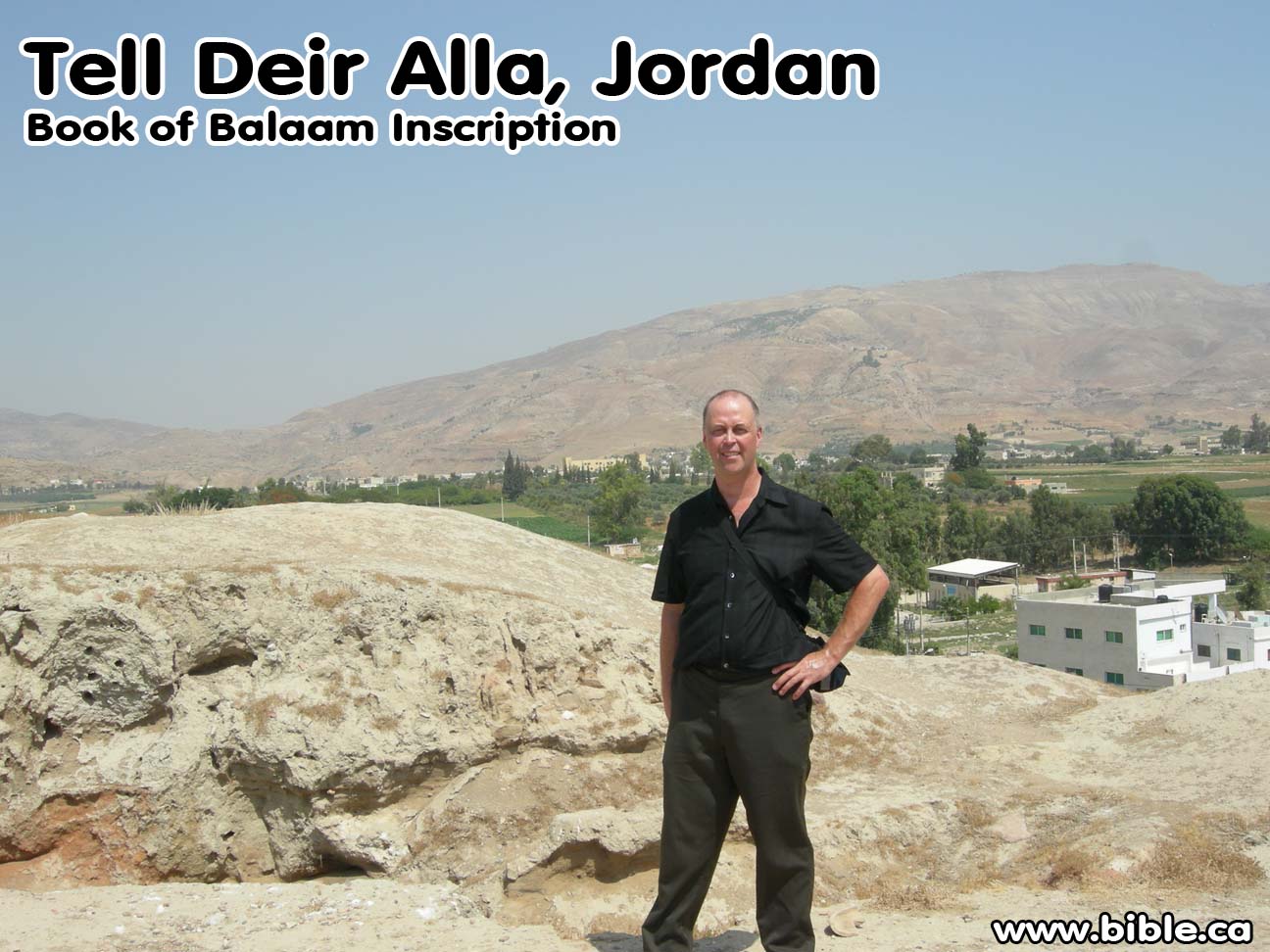
2. AMARNA TABLETS: The story of the conquest of Joshua as told by the Amarna Tablets:
a. Crossing the Jordan in 1406 BC, 40 years from the exact day they left Egypt.
b. The Conquest took 6 years and on the first sabbatical year of 1399 BC they set up the
c. Tabernacle tent at Shiloh where it stood for 305 years until 1194BC.
d.
Read full outline on the Conquest
of Joshua, as told by the Amarna Tablets in Egyptian cuneiform.
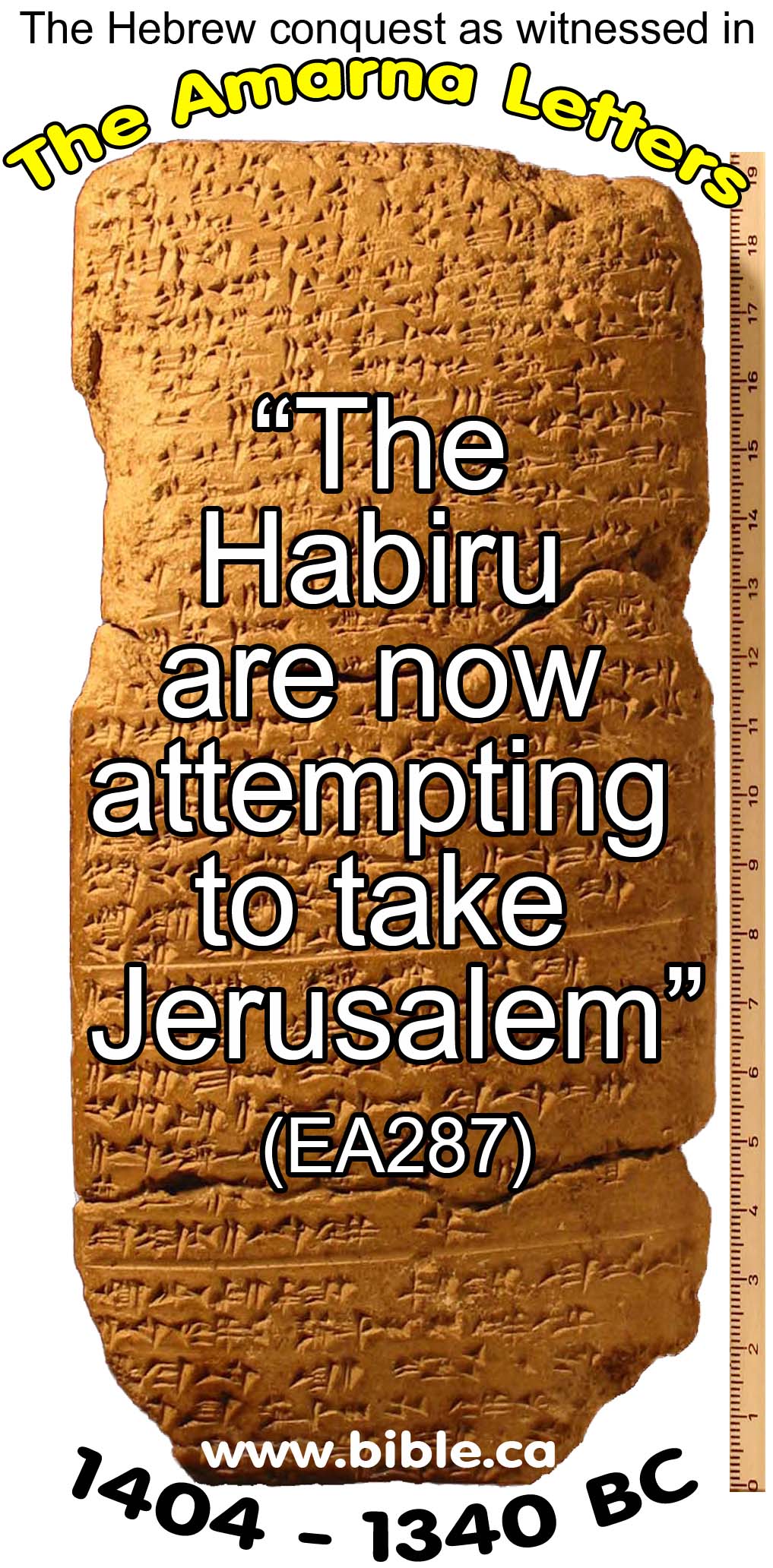
3. King Jabin of Hazor: 1700 BC: Read full outline
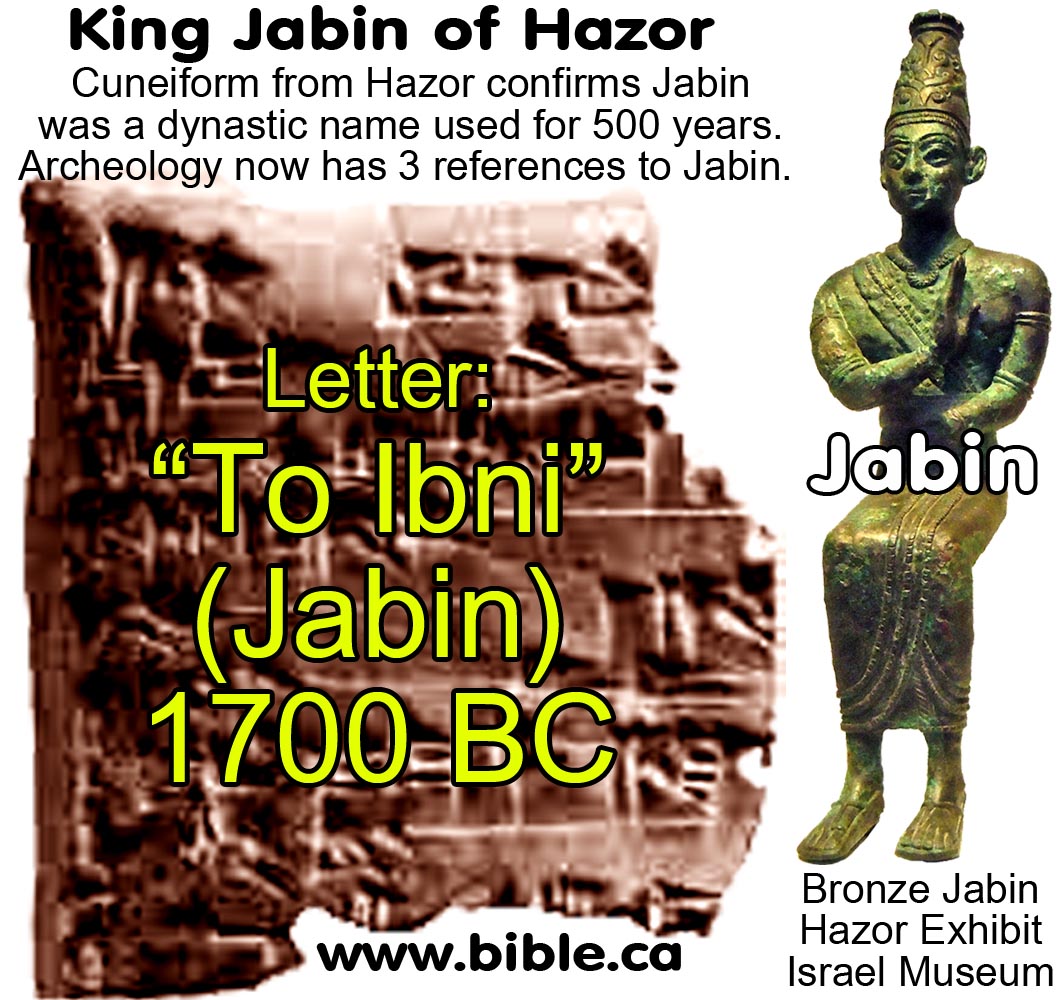
a. Two 18th century inscriptions have been found at Mari and Hazor with the name Jabin proving it is a dynastic name for all the kings of Hazor that lasted over 500 years.
i. Bible Skeptics accused the writer of Judges with confusion since both Joshua and Deborah defeated a king named “Jabin”.
ii. Now we know that Jabin was not his name, but a title like Pharaoh.
iii. Jabin of Joshua and Deborah was a dynastic name for the king of Hazor.
iv. The Bible is never wrong and once again the Bible skeptics HIT THE MAT in defeat!
b. Five different references to Jabin of Hazor
i. Archeology now has uncovered a total of three different references to Jabin, in addition to the two Bible references to Jabin of Joshua (1406 BC) and Deborah (1200 BC). This proves the Bible was right all along and that "Jabin" is a dynastic name for a series of kings rather than the one time use of a single king. Two 18-17th century inscriptions have been found at Mari and Hazor with the name Jabin. A third is on the names list of Ramesses II at the Amon Temple at Karnak 1279-1212 BC.
ii. The Accadian tablet from Mari reads: “Ibni-Addad king of Hazor.” (18th century BC)
iii. The Old Babylonian tablet letter from Hazor is actually addressed "To Ibni". (18-17th century BC)
iv. The Ramseese II namelist at Karnak reads: "Qishon of Jabin"
c. Read full outline on Jabin.
Conclusion:
1. The archeological evidence of Israel in Egypt, the oppression and the Exodus is overwhelming.
2. The Translation of the 16 Sinai inscriptions fills in huge gaps of the archeological record.
a. All 16 inscriptions are discussed in scholarly detail in Doug’s book in such a way that the novice can understand it.
b. Canadian Researcher, Dr. Doug Petrovich is the first person in history to translate these 16 inscriptions and it all started when he realized they were in ancient Hebrew. This refutes the previous notion that Phoenician was the first alphabet and proves beyond doubt that Phoenician was derived directly from Hebrew which is in fact the true Proto-Canaanite alphabet.
c.
We now also know of four different Hebrew alphabetic
scripts, thanks to the translation skills of Dr. Doug Petrovich. This changes
everything! BUY
HIS AMAZING BOOK.
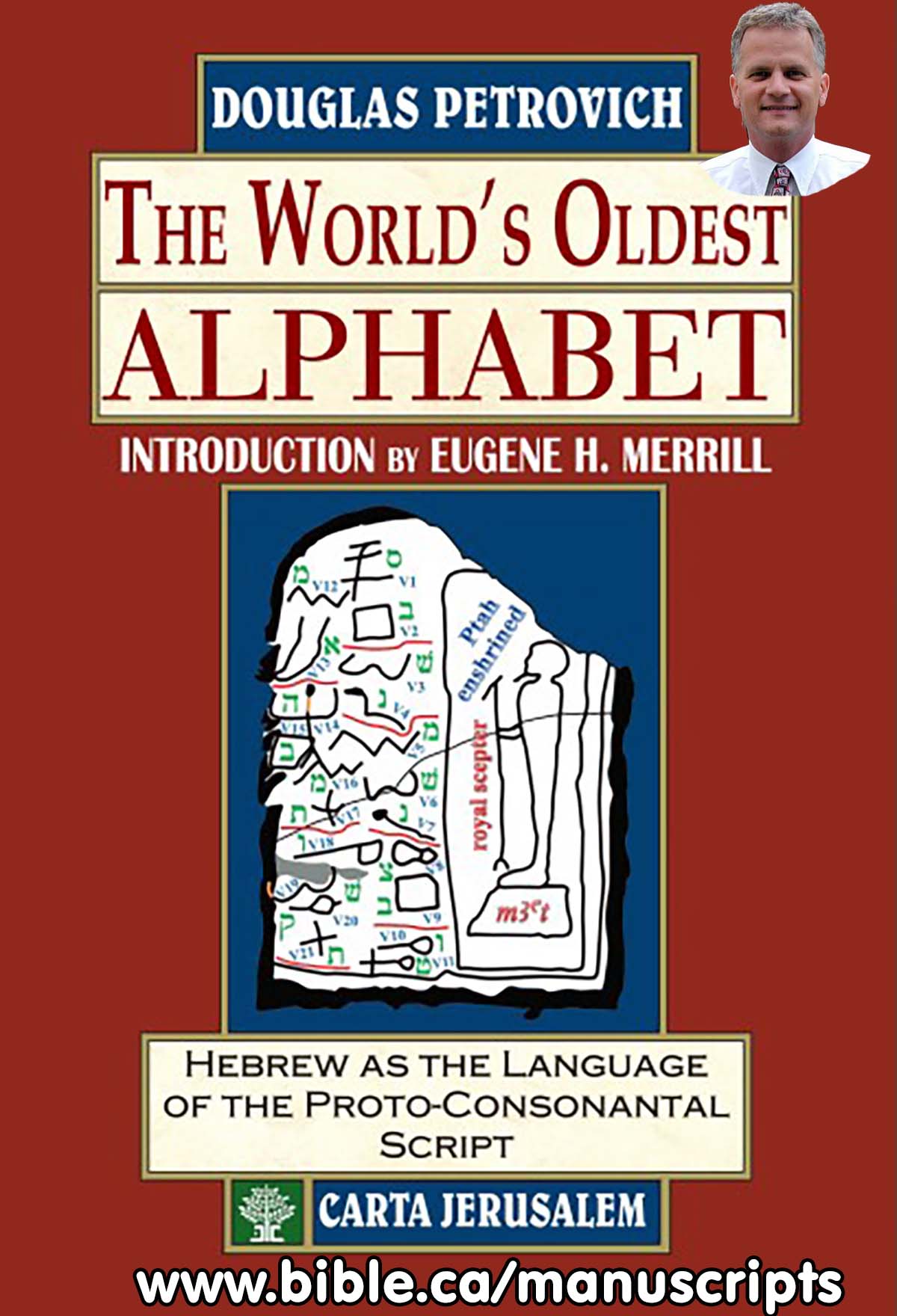
3. Why not attend a local group of Christians in your own home town this Sunday!
|
ATTEND CHURCH THIS SUNDAY! Trust the Bible as God’s message to your life!
Click here to find Christians meeting in your own home town.
|
By Steve Rudd: Contact the author for comments, input or corrections.
